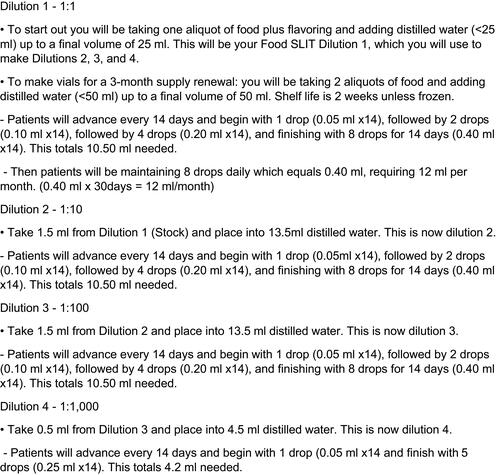Abstract
Food SLIT (sublingual immunotherapy) is a food desensitization method with a daily maintenance dose of <10 mg for up to 5 years. Many protocols use commercially available skin test extracts. Oral immunotherapy (OIT) treatment solutions have consistent protein concentrations, are comparatively cheaper and customizable and therefore were adapted for use in a published SLIT dosing schedule.
Food Sublingual Immunotherapy (SLIT) is a food desensitization method with a typical daily maintenance dose of <10 mg protein for up to 3–5 years, which has been shown to increase tolerance in hazelnut and peanut allergic patients in randomized, double-blind, placebo-controlled trials.Citation1,Citation2 In SLIT, intact food protein is given sublingually to the tolerogenic antigen-presenting Langerhans cells, held for 2 minutes, and then swallowed or spat out. Starting doses are at the microgram level and increase to milligram doses by maintenance.Citation3 SLIT buffers against unintentional food exposure while maintaining a favorable safety profile with mostly transient oropharyngeal itching in less than 5% of peanut SLIT doses.Citation4 Many published SLIT protocols use commercially available skin test extracts.
Skin test extracts have relatively higher protein concentration variability and cost, and lower customizability in comparison to Oral Immunotherapy (OIT) solutions. Egg and milk skin test extracts contain 2–4 mg protein per milliliter, while peanut extract contains 4–8 mg protein per milliliter at an approximate price of 4 US dollars per mg protein.Citation5 Allergists collaborate to develop and refine OIT protocols which yield solutions with reasonable protein concentration consistency.Citation6,Citation7 Since actual food is used to make OIT solutions, the cost is orders of magnitude less. Although OIT solutions have a shorter shelf life than skin test extracts, they can be frozen for future use.Citation8 An OIT solution can be made to approximate the protein concentration of a skin test extract and substituted for the skin test extract used in a published SLIT protocolCitation4 () and is found to dispense easily (). If for any reason, the maintenance dose needs to be adjusted, the OIT solution can be customized without changing the protocol, which is difficult to do with skin test extracts which have variable, fixed protein concentrations ().
Table 1 Summary of Food Amounts Needed to Create a SLIT Maintenance Vial Using an OIT Dosing Protocol
We hope that this adaption of OIT solutions for use in available SLIT protocols improves the access to consistent, economical, and customizable food desensitization.
Disclosure
Dr Joshua Jacobs reports consultancy fees and contracted research from Aimmune, outside the submitted work. The authors report no other conflicts of interest in this work.
References
- Enrique E, Pineda F, Malek T, et al. Sublingual immunotherapy for hazelnut food allergy: a randomized, double-blind, placebo-controlled study with a standardized hazelnut extract. J Allergy Clin Immunol. 2005;116(5):1073–1079. doi:10.1016/j.jaci.2005.08.027
- Fleischer DM, Burks AW, Vickery BP, et al.; Consortium of Food Allergy Research (CoFAR). Sublingual immunotherapy for peanut allergy: a randomized, double-blind, placebo-controlled multicenter trial. J Allergy Clin Immunol. 2013;131(1):119–127. doi:10.1016/j.jaci.2012.11.011
- McGowan EC, Wood RA. Sublingual (SLIT) versus oral immunotherapy (OIT) for food allergy. Curr Allergy Asthma Rep. 2014;14(12):486. doi:10.1007/s11882-014-0486-9
- Kim EH, Yang L, Ye P, et al. Long-term sublingual immunotherapy for peanut allergy in children: clinical and immunologic evidence of desensitization. J Allergy Clin Immunol. 2019;144(5):1320–1326. doi:10.1016/j.jaci.2019.07.030
- Communication with N. Isenhour, Sept 12, 2019, Stallergenes Greer Inc. Ingestant egg, milk, peanut extracts. 55 Cambridge Parkway, Suite 400, Cambridge, MA 02142.
- Filep S, Block DS, Smith BR, et al. Specific allergen profiles of peanut foods and diagnostic or therapeutic allergenic products. J Allergy Clin Immunol. 2018;141(2):626–631. doi:10.1016/j.jaci.2017.05.049
- Wasserman R. OIT packet nuts and other foods; North Texas. Available from: www.allergypartners.com. Accessed April 14, 2021.
- Sagara N, Fujita S, Suzuki R, et al. Successful sublingual immunotherapy for severe egg allergy in children: a case report. Allergy Asthma Clin Immunol. 2021;17(1):1–4. doi:10.1186/s13223-020-00506


